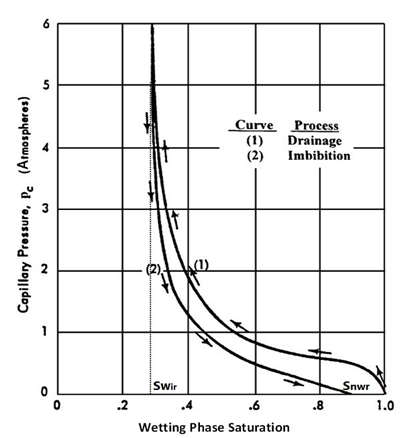Fundamentals of Fluid Flow in Porous Media
Chapter 2
Multi-phase Saturated Rock Properties:
Capillary Pressure Hysteresis
It is generally agreed that the pore spaces of reservoir rocks were originally filled with water, after which oil moved into the reservoir, displacing some of the water and reducing the water to some residual saturation. When discovered, the reservoir pore spaces are filled with a connate water saturation and an oil saturation. All laboratory experiments are designed to duplicate the saturation history of the reservoir. The process of generating the capillary pressure curve by displacing the wetting phase, i.e., water, with the non-wetting phase (such as with gas or oil), is called the drainage process. This drainage process establishes the fluid saturations which are found when the reservoir is discovered. The other principal flow process of interest involves reversing the drainage process by displacing the non-wetting phase (such as with oil) with the wetting phase, (e.g., water). This displacing process is termed the imbibition process and the resulting curve is termed the capillary pressure imbibition curve. Figure 2‑61 shows typical drainage and imbibition capillary pressure curves. The two capillary pressure-saturation curves are not the same.

Figure 2-61: Capillary Pressure Curve
As can be seen in Figure 2‑61, the reduction of non-wetting phase saturation, Snw, or alternatively an increase in the wetting phase saturation, Sw, is much less over the same incremental change in pressure during drainage, i.e., there is capillary pressure hysteresis:

On the other hand at the same saturation capillary pressure in imbibition and drainage process are different. This difference in the saturating and de-saturating of the capillary-pressure curves is closely related to Contact Angle Hysteresis during the displacement.
Questions?
If you have any questions at all, please feel free to ask PERM! We are here to help the community.
